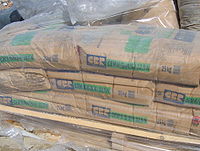
Photo from wikipedia
A composite mineral binder was prepared by mixing ground granulate blast furnace slag (GGBS) and steel slag (GGBS/steel slag ratios are 1 : 1 or 3 : 2 by mass). The application of a… Click to show full abstract
A composite mineral binder was prepared by mixing ground granulate blast furnace slag (GGBS) and steel slag (GGBS/steel slag ratios are 1 : 1 or 3 : 2 by mass). The application of a composite binder in a massive concrete structure under severe sulphate attack is discussed by determining the hydration heat, adiabatic temperature increase, compressive strength, elastic modulus, chloride ion permeability, and sulphate attack resistance. The results show that the hydration heat of the composite binder decreases greatly when the cement replacement ratio increases to 50% at 45°C. The adiabatic temperature rise of the concrete containing the composite mineral admixture decreases significantly. Concrete containing the composite mineral admixture has a lower early elastic modulus and satisfactory late-age compressive strength. The composite mineral admixture can improve the resistance to chloride ion permeability and sulphate attack resistance of concrete, especially during temperature match curing.
Journal Title: Advances in Materials Science and Engineering
Year Published: 2017
Link to full text (if available)
Share on Social Media: Sign Up to like & get
recommendations!